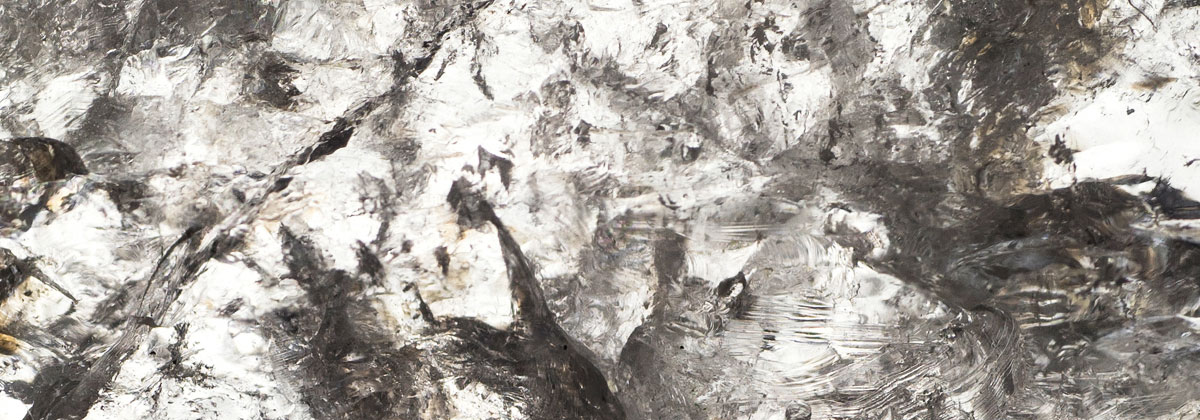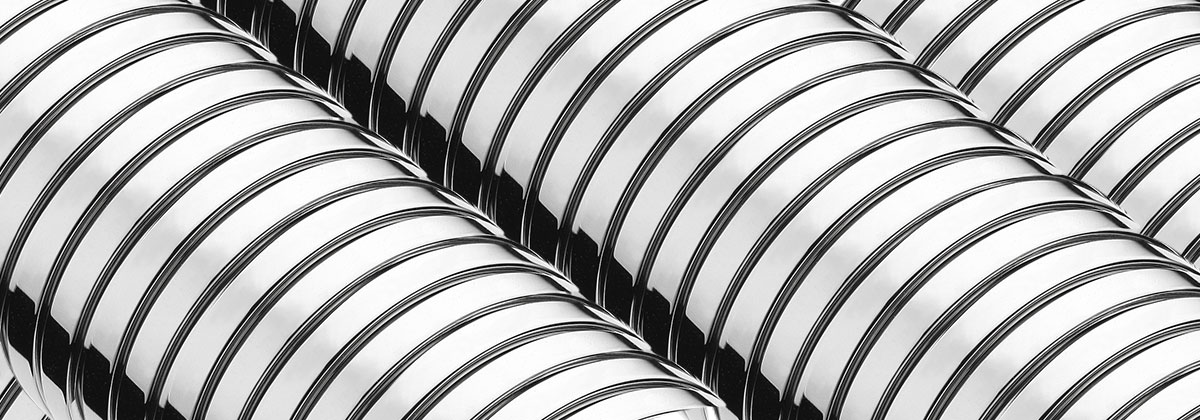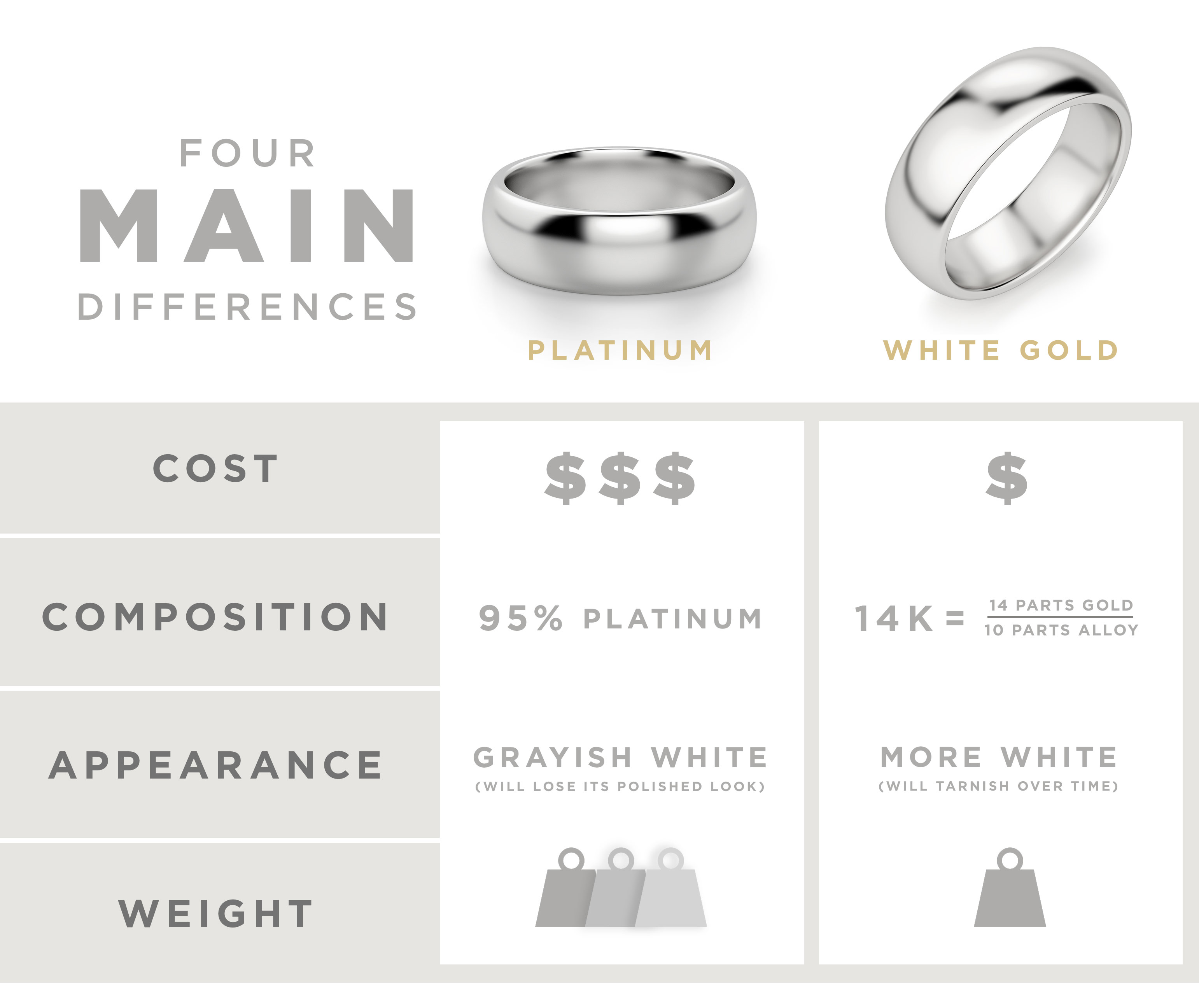Platinum vs White Gold Wedding Bands: A Guide to Radiant Rings
November 20th, 2023 / Alese Oldenburg
If your big day is rapidly approaching then you’ve probably started to think about your wedding bands for the ceremony. In terms of what to know when buying an engagement ring, this style of ring is known for its striking styles featuring a diamond center, like a halo or three-stone diamond ring, and is sometimes seen as a more important purchase in regards to traditional or simulated diamond jewelry. However, wedding bands should be thought about rigorously, and are a great addition when you are figuring out how to wear your wedding ring best. Plus, there are many exciting options to choose from that elevate the traditional simple wedding bands, including stackable wedding bands and eternity bands. There are also many unique men’s wedding band options on the market. At the end of the day, you and your partner’s wedding bands and your engagement ring should embody your relationship and everything that makes it so unique, just as your engagement ring does. While the diamond cut, the setting, the style, and all the details are important, what’s just as important is the precious metal of the ring.
Wedding bands are often more simple in design than engagement rings, but that’s not always the case. Metals and stones for engagement rings can feature anything from dazzling accents and precious materials to intricate metalwork and more. But whether you opt for modern styles, or classic wedding bands that won’t go out of style, you’ll need to decide which metal type is right for you and your significant other. You’ll also need to decide whether or not you’d like diamonds to make an appearance on your wedding band; to learn more about diamond size options, visit our diamond carat size chart.
From yellow gold to white gold metals, there are quite a few options to choose from. Another choice: platinum. Platinum engagement rings and wedding bands do look very similar to white gold engagement rings and wedding bands. That’s why a common question we hear a lot is, “What’s the difference between a platinum vs. white gold wedding band?” These two metal types look a lot alike, but they’re surprisingly different in a lot of ways. Before you decide which metal type is right for you, learn the top differences between platinum and white gold jewelry, specifically, wedding bands.
White Gold Wedding Bands
Wedding bands made of gold are one of the most popular options around—especially white gold. While the name suggests a white color, it looks closer to silver than white. There are many different options when it comes to white gold. Here are the top three most frequently purchased white gold metal types:
- 10k: This option contains the lowest amount of actual pure gold, as its ratio is 10 parts gold and 14 parts alloy mixture. While this fact may make it seem like a less desirable choice, 10k gold is the most durable out of the top three choices. That’s because pure gold is weaker than other alloys, meaning the added alloys help the metal to be strong and extremely durable for an everyday piece of jewelry. This option is also the cheapest of the three. So, if you’re looking for a metal that’s affordable and durable, 10k white gold may be a good option for you.
- 14k: By far the most popular choice, 14k white gold jewelry is a great combination of affordability and durability for both women’s and men’s wedding bands. It is made of 14 parts gold and 10 parts alloy mixture. This makes it ideal for fine jewelry because it’s made mostly of gold but features enough alloys to keep it durable and heirloom quality. This is the middle ground for the price as it’s more expensive than 10k and less expensive than 18k.
- 18k: If you want to invest a little more into your wedding band, then 18k white gold may be the right choice for you. Since it contains 18 parts gold and only 8 parts alloy mixture, it’s more heavily made of gold rather than cheaper alloys. While this may seem like a plus, there is also a downfall to having more gold. Remember, gold is a rather weak metal, meaning 18k gold will be more prone to scratching over time. However, if you plan to be very gentle with your ring and take it off when appropriate, you shouldn’t have too many problems with this choice.

Platinum Wedding Bands
A pure platinum ring is an excellent metal choice for classic and non-traditional wedding rings. It features a glossy finish that looks similar in color to white gold. Although a platinum engagement ring might appear similar to a white gold ring, there are some key differences between platinum and other metal types.
Platinum jewelry is considered one of the most durable metals for both wedding bands and engagement rings. Unlike gold or silver, it does not tarnish and tends to need the least amount of maintenance over time. If you’re curious about whether or not rose gold tarnishes or fades, we’ve written in detail about this on our blog. In terms of platinum, along with its durability and hardness, it’s actually heavier than other metals. That means it feels like a more luxurious metal type and helps ground your ring.
One of the biggest misconceptions about platinum jewelry is that its durability prevents it from being scratched. Although platinum jewelry is extremely strong, it is still prone to scratching, similar to 14k gold. When a gold wedding band gets scratched some metal is actually lost, which is why it appears as a scratch. On the other hand, when platinum gets scratched the metal is merely moved, not lost. This results in a natural patina finish, or a less polished and worn appearance, which some consumers actually like more than its original glossy appearance.
Because of platinum’s clear benefits over gold, it is increasing in popularity. But, some consumers are still not convinced that spending more money upfront is worth it. To deep dive into the differences between a white gold ring and a platinum wedding ring, learn all of the most important distinctions between the two metals to find out which one is right for you and your new spouse.
Platinum vs White Gold Wedding Bands
The main differences between platinum and white gold jewelry lie in a few different factors: the cost, the composition, the appearance, and the weight. While platinum bands tend to be around 10-40% more than white gold bands depending on where you shop, they also tend to last longer due to tarnishing and wear and tear. As far as the composition goes, platinum wedding bands are around 95% platinum whereas white gold is a mixture of gold and alloy, depending on the quality of the gold you buy. While one of the most known differences is the cost comparison, there are many more differences that you should be aware of before purchasing your ring. Keep these few things in mind during your search for the right platinum vs white gold wedding band.

- Price Difference of Platinum vs White Gold: Again, the biggest difference between the two metals is when looking at the upfront cost. Platinum wedding bands tend to be a fair amount more than gold, although it’s important to also think about long-term costs. If your choice is between white gold and platinum, consider what the cost of maintenance will be throughout the years. If you are looking for an affordable engagement ring or wedding band, consider going with a white gold engagement ring band. However, a white gold ring is more prone to wear and tear and needs to be rhodium dipped every couple of years or so to maintain its white appearance. Keep in mind, that some jewelers include this for free with white gold purchases. Although, if it’s not covered, while not an expensive fix, the cost can add up over the years. Since platinum is less prone to tarnishing, there should be fewer trips to the jeweler throughout the years, making the initial investment worth it to many consumers.
- Composition of Platinum vs White Gold: Depending on the karat of the white gold wedding ring you choose, the composition will differ. The most common karat of gold for wedding bands and engagement rings is 14k, which is comprised of 14 parts gold and 10 parts alloy mixture. Specifically, white gold jewelry contains white metals like silver, nickel, and palladium, and is finished with a rhodium plating or coating. On the other hand, platinum bands must contain at least 95% platinum to be considered pure. Since platinum is purer, it tends to be a great hypoallergenic choice as the alloys found in gold can be irritating to some and cause your skin to turn color during everyday wear.
- Appearance of Platinum vs White Gold: Platinum and white gold wedding bands do look a lot alike, but there are still some minor differences in appearance. First, since white gold is mixed with other alloys and then rhodium dipped it appears whiter, while a platinum setting features a more grayish-white appearance that appears to have more shine. Another key difference is wear and tear. While white gold may tarnish where it is most frequently rubbed—like the sides that touch your fingers—platinum, on the other hand, will merely appear less polished over time. So while it’s inevitable that white gold will need to be re-rhodium dipped eventually, some consumers like the look of the less polished platinum band and choose to not get it re-touched.
- Weight Difference in Platinum vs White Gold: The last key difference between pure platinum and white gold wedding bands is the weight. Platinum jewelry is quite a bit heavier than gold, which gives it a more substantial feel. If you’re worried it will be too heavy to wear every day, consider how thick you want your ring to be. The thicker it is, the heavier it will feel. For rings for glamorous brides, this usually means a heavy piece of jewelry. If you’re thinking about purchasing online but want to get a feel for the different weights, it may be a good idea to head to the nearest jeweler and try them on first. Feeling it on your finger may give you a better idea of how your actual ring will feel.
Choose The Right One for You
If you’ve read all there is to read about the differences between white gold and platinum and you’re still not sure which is right for you, then there’s just one last thing to do: try them on. While the two metals may seem similar, they will no doubt look and feel differently. Trying on both metal types will hopefully push you in the right direction depending on your personal preference. While the idea of a platinum ring or other platinum jewelry and its many benefits may seem like the right choice, you may find out you don’t like the look of it or vice versa. A wedding band is a major purchase, one you will wear every day for the rest of your life, so you want to ensure you choose the precious metal type that you will love for years to come.
Once you’ve decided on a white gold vs platinum engagement ring or wedding band, you may want to decide on the diamond shape and cut as well. When it comes to finding the perfect diamond to complete the look, consider a diamond Simulant.
The Nexus Diamond™ Alternative is a great option to find the perfect stone for up to 90% less than a naturally mined diamond.
*Diamond Nexus strives to provide valuable information, while being clear and honest about our products. The Nexus Diamond™ alternative is a patented lab grown stone that, among all simulants, most closely imitates the look, weight and wear of a mined diamond, with two exceptions – it is absolutely perfect in every way, and it costs significantly less. Price points and environmental facts expressed in this blog were taken from popular online retailers and may vary. Learn more about the environmental impact of mining by visiting our blog.

